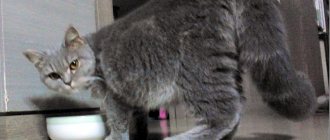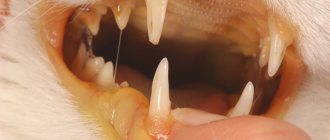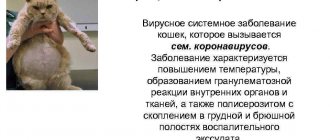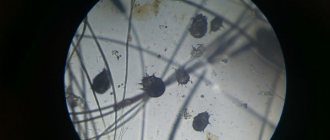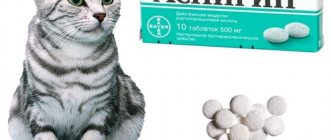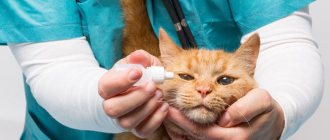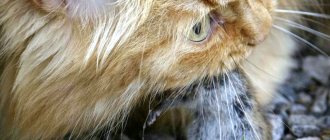What is peritonitis and why does it develop in cats?
Peritonitis (from the Latin peritoneum - peritoneum, -itis - inflammation) is an inflammation of the serous membrane (peritoneum), which covers the internal organs located in the abdominal cavity of the animal.
Causes of peritonitis in cats:
- Failure of the immune system. The disease most often affects young cats, under 2 years of age, as well as older animals (over 10 years old). In kittens and young cats, the immune system is still imperfect and is not ready to withstand severe infections. At older ages, the activity of the immune system decreases and loses the ability to fully protect against infections.
- Living outdoors or with a large group of animals. More often, the disease affects cats that live on the street, in nurseries, as well as pets that live in private homes and can go for walks. Such cats are more likely to become infected with pathogens.
- Poor pet care. Poor nutrition or failure to comply with animal hygiene rules.
Prevention of peritonitis in animals
Veterinary experts recommend following the rules to prevent the development of a dangerous disease:
- Do not allow animals to be kept crowded.
- Limit free range.
- Disinfect the room regularly.
- Follow the norms and rules of feeding.
- Increase immunity.
- Follow recommendations for postoperative care.
We recommend reading about endometritis in cats. You will learn about the reasons for its development, forms of endometritis, symptoms, complications, diagnosis and treatment. And here is more information about the causes and treatment of vomiting in cats.
Types of disease
The disease has two main classifications.
Classification due to the development of peritonitis
According to etiology (reason for development), peritonitis is divided into:
- infectious nonspecific;
- infectious postoperative;
- infectious specific (viral);
- invasive;
- non-infectious.
Infectious nonspecific peritonitis
The disease develops as a result of injury to the animal, which is accompanied by a violation of the integrity of the abdominal wall and/or damage to internal organs. This can happen during street fights, road accidents, falls from a height, or eating inedible sharp objects (buttons, thorns, etc.).
An injury sustained by a cat in a fight can cause infectious nonspecific peritonitis.
When internal organs are damaged, their contents (stomach, intestinal) or blood (due to vascular damage) are released into the abdominal cavity. These substances lead to the release of pathogenic microflora into the abdominal cavity and irritation of the peritoneum, as a result of which an active inflammatory process develops - peritonitis.
Inflammatory diseases of the liver, kidneys, and intestines are also the cause of the development of infectious nonspecific peritonitis. The pathological process from these organs can move to the peritoneum and lead to the development of peritonitis.
Infectious postoperative peritonitis
It develops as a complication after surgical interventions due to non-compliance with the rules of asepsis and antisepsis (sterility conditions) during surgery. Most often, pathology occurs after sterilization of a pet.
Therefore, it is necessary to take the choice of a clinic for sterilization seriously, by reading online reviews about the institution or consulting with friends who have visited this clinic.
Infectious specific (viral) peritonitis
The cause of the disease is infection of a cat with coronavirus (FECV - Feline Enteric Coronavirus or FIPV - Feline Infectious Peritonitis Virus). Most cats have FECV in their bodies, but it lies dormant and does not cause disease. When exposed to unfavorable conditions (injuries, severe concomitant diseases) or weakened immunity, it first causes inflammation of the intestines (enteritis), and then can mutate and cause the formation of peritonitis in the cat.
In other cases, a pet may immediately become infected with the FIP virus, which will lead to the development of peritonitis.
Video: feline viral peritonitis (FIP)
Invasive peritonitis
The disease occurs due to the proliferation of worms in the cat’s body, which can close the intestinal lumen and lead to its perforation (rupture).
Non-infectious peritonitis
In this case, the cause of the development of the pathological condition is the influence of thermal or chemical (acid-containing substances) factors. The process is non-infectious, since the cause of the formation of the disease in this case is external, but the possibility of the addition of viral or bacterial flora in the future cannot be ruled out. Then the disease becomes infectious.
Classification according to the form of the disease
According to the form of the disease, it is divided into:
- exudative (wet);
- proliferative (dry).
Exudative form of the disease
More than 70% of cats suffer from this form of peritonitis. After the virus enters the animal’s body, it begins to actively divide and enters the blood, as a result of which the normal functioning of the vascular walls is disrupted. Through the wall of blood vessels, fluid from the bloodstream begins to seep into the tissues and accumulate in the free cavities of the body: abdominal, pleural (around the lungs), pericardial (around the heart).
More often, fluid accumulates in the abdominal cavity and leads to ascites (externally this is manifested by a significant increase in the size of the abdomen)
Based on the nature of the fluid, exudative peritonitis is distinguished:
- purulent (formed in the presence of bacteria);
- serous (yellowish liquid formed from blood due to its leakage through the vascular wall);
- fibrinous (a protein substance of a whitish-gray color);
- hemorrhagic (blood);
- fecal;
- bile.
Often there is a combination of several types of fluids, for example, serous-fibrinous or fibrinous-purulent wet peritonitis.
The wet form of peritonitis develops acutely and is more malignant than the dry form.
Dry form of the disease
It is manifested by the development of inflammatory foci - granulomas in various organs of the animal (liver, intestines, kidneys, lymph nodes, etc.). An inflammatory focus that has developed in one organ is a source of chronic infection and promotes the spread of inflammatory cells through the bloodstream to other organs of the cat. Granulomas lead to disruption of the normal functioning of the affected organs and the inability to perform their functions, as a result of which all metabolic processes in the animal’s body are disrupted, which can lead to multiple organ failure.
The course of the disease is chronic, the symptoms of the disease develop over several months, so the presence of the disease in a pet is difficult to recognize.
In some cases, the disease can change from one form to another: from exudative peritonitis (subject to timely treatment) it turns into dry peritonitis, which prolongs the life of the animal from several months to a year.
PATHOGENESIS
The occurrence of FIP is associated with a mutation of the feline coronavirus (FCoV). When infected with coronavirus, virus replication occurs in the epithelial cells of the respiratory tract and intestines. The initial stage of feline coronavirus is usually asymptomatic, but in rare cases it manifests as mild to moderate enteritis. The mutation of coronavirus into viral peritonitis most often occurs after a stressful situation in a cat’s life, accompanied by a decrease in the body’s immune status.
By infecting the intestinal epithelium, feline coronavirus FCoV passes through the intestinal mucosal barrier, mutates into infectious peritonitis (FIP) and replicates in monocytes/macrophages, gaining access to the blood. Further, IPC, accumulating in the walls of blood vessels, increases their permeability, this leads to the removal of proteins from the blood vessels and the formation of effusion fluid. Thus, the “wet” or exudative form of viral peritonitis develops. Typically, the exudative form appears within 3–6 weeks after a stressful situation in the cat’s life.
The “dry” non-exudative form of viral peritonitis passes without changing the permeability of the walls of blood vessels and is characterized by the formation of granulomas in the internal organs.
The serological ELISA test for determining antibodies to coronavirus infection in cats, used by the Chance Bio laboratory, also proves the relationship between coronavirus (FCoV) and feline infectious peritonitis (FIP). About 80% of cats with FIP peritonitis had a high titer of antibodies to coronavirus >1:160, the remaining 20% had a titer in the range of 1:20-1:160, which also confirms feline coronavirus disease (FCoV).
Ways of infection with peritonitis
Scientists identify three ways of transmitting the disease:
- fecal-oral;
- airborne;
- from mother to fetus.
The main route of transmission is fecal-oral, that is, through the mouth.
The virus is released in the feces, urine and saliva of an infected animal into the environment, and then transferred to soil and plants. That is why animals that have frequent contact with the street and street cats are susceptible to infection. Also, the causative agent of the disease may be present in low-quality or poorly processed food products, or in dirty water.
A pet can become infected while playing with the owner’s outdoor shoes or objects brought from the street.
Even domestic cats that never go outside can become infected with peritonitis from objects brought into the house by the owner, including shoes.
The second most common route of infection is airborne transmission. In cats that have frequent contact with other animals, the likelihood of developing the disease increases significantly. Domestic cats can become infected at exhibitions if they have close contact with infected animals.
The third route of infection is transmission of the virus to a kitten from an infected mother while feeding it with milk. However, these cases are extremely rare.
Genetically determined susceptibility - some cat breeds are likely to be more susceptible. This suggests that there is a genetic predisposition to the development of infectious peritonitis, possibly related to the major histocompatibility complex gene.
Karpetskaya N.L., veterinarian
https://www.elite-line-cats.com/%D0%BA%D0%BE%D1%80%D0%BE%D0%BD%D0%B0%D0%B2%D0%B8%D1%80 %D1%83%D1%81/
Is it possible to cure an animal and how long will it live?
The causative agent of infectious peritonitis is a representative of the Coronaviriadea group, it is distinguished by selective activity. In some animals, the virus causes irreversible pathological disorders. However, some infected individuals do not become ill. Scientists cannot yet determine what causes this selectivity.
Pathology often occurs in conditions of poor sanitation. Foreign agents enter the cat’s body through the oral-fecal or airborne route. A cat can become infected by eating food that contains the virus or by sniffing the feces of a sick animal. Close contact with infected relatives also often causes infection.
This type of pathogenic organism is able to survive in the environment for up to 30 days. Some scientists believe that the virus can cross the placental barrier and be transmitted from mother to offspring.
There is another hypothesis according to which infection does not always occur through contact with a sick animal. At first, the virus is relatively safe and lives in the cat’s body, then it mutates and begins to exhibit pathological activity.
According to statistics, the disease is poorly treated and in most cases leads to the death of animals. For this reason, veterinarians do not give favorable prognoses even when viral peritonitis is detected in cats at an early stage. No doctor can guarantee that drug therapy will be effective and the pet will recover.
The mortality rate of animals from viral peritonitis with early treatment is about 90%. If therapy is started late, animals die in 100% of cases.
The life expectancy of a cat depends on the form of peritonitis. With exudative, a sick animal can live for several days or weeks. In this case, the disease progresses very quickly, fluid constantly accumulates in the abdominal cavity, breathing becomes difficult, and kidney failure develops. A positive result is the transition of exudative peritonitis to a dry form.
With proper treatment of the proliferative type of pathology, a pet can live for several years. The disease develops slowly. If you maintain the functioning of the affected organs, the pet will live long enough. It is extremely rare to achieve complete recovery.
The question of the possibility of a person becoming infected from their pet worries many cat owners, since therapy for viral peritonitis does not always end successfully. There is a hypothesis that the coronavirus is similar to HIV and poses a danger to people.
We invite you to read: Review of the range and assessment of the composition of Guabi cat food
However, experts confidently say that this type of virus does not affect people. It is impossible to get infected from a cat, so there is no need to be afraid that the infection will be passed on to a child or adult. Pathogenic microorganisms are only dangerous for cats that have contact with a sick animal.
Feline viral peritonitis is thought to be similar to human immunodeficiency virus. There is a myth that the disease can be transmitted to humans, but this is not the case at all.
The coronavirus mutates greatly, so it first attacks the cat's immune system. This is where the similarities with AIDS stop. The owner, even in close contact, has nothing to fear; there is no risk of infection for him.
At the moment, vaccination against peritonitis is the only hope for ensuring the safety of your pet. However, the drug Primucel is considered a single prophylactic drug, and it does not provide a 100% guarantee of protection.
The cat is injected with a weakened virus that spreads only in the upper respiratory tract, as a result of which it should develop strong mucosal immunity.
To protect your cat from getting sick, you need to keep the room clean, and it is advisable to disinfect it from time to time. Strengthening the immune system will prevent the occurrence of infectious and viral diseases.
Symptoms of the disease in cats
Manifestations differ depending on the form of the disease.
Symptoms of wet peritonitis:
- loss of appetite, up to complete refusal of food;
- significant loss of body weight;
- decreased activity (the cat stops playing, running, and spends more time just lying or sleeping);
- increase in abdominal size (ascites);
- the cat reacts painfully to touching its stomach;
- prolonged increase in body temperature;
- convulsions may occur;
- in severe cases - shortness of breath even with light exertion;
- bowel dysfunction (constipation is more common, diarrhea may be less common).
Symptoms of dry peritonitis:
- decreased appetite;
- gradual weight loss;
- impaired urine output (incontinence);
- bowel dysfunction (constipation is more common, diarrhea may be less common);
- apathetic or unusual behavior for a cat;
- convulsions;
- impaired coordination of movements;
- yellowness of the skin and mucous membranes;
- eye diseases (opacity of the vitreous body, cornea, damage to the choroid - uveitis), which leads to decreased or loss of vision;
- in severe cases - paralysis of the limbs (usually the lower ones).
I believe that even at the slightest suspicion that a cat is developing such a dangerous disease as peritonitis, you should immediately contact a veterinarian. It is better to be an “overly caring” owner than to then watch the suffering of your pet.
Risk factors
Coronavirus affects different systems:
- Multisystems. Damage occurs to the omentum, the mucous membranes of the liver, kidneys, and intestines. Common in dry form of the disease.
- Respiratory systems. The surface of the lungs is affected, and pleurisy forms due to effusion. Most often occurs with dry peritonitis.
- Nervous. Lesions are observed throughout the nervous system.
- Ophthalmological. Lesions are observed around the eyes.
Pets of all breeds suffer from peritonitis, but the incidence rate increases in exotic cats. Of the sick animals, 56% are purebred cats. Peritonitis occurs in 80% of younger animals, with a high prevalence in individuals from 3 months to 3 years. In adult cats, the disease is less common; it is more common in older animals, older than 10 years. The risk group includes pets kept in a pack.
Diagnosis of disease in cats
Diagnosis of peritonitis is carried out in several stages:
- Anamnesis collection.
- Carrying out an examination of the animal.
- Laboratory examination.
- Instrumental examination.
History taking
The veterinarian finds out what symptoms alerted the owner of the pet, where it was taken from (from the street, a nursery or from other owners). Also, whether the animal had any operations and if so, when. An important issue is the cleanliness of the habitat, hygiene and the quality of the animal’s diet. And also whether there was contact with a large group of animals recently.
Carrying out an inspection
The doctor listens to the pet’s lungs, palpates the abdomen, measures body temperature and carefully examines the skin.
Laboratory examination
First of all, a blood, urine and stool test is taken. However, these methods are nonspecific and will only help identify the inflammatory process.
To detect the pathogen, special blood tests are performed:
- PCR (polymerase chain reaction, detects the presence of viral DNA in the animal’s body).
- ELISA (enzyme-linked immunosorbent assay, determines the concentration of antibodies to the causative agent of the disease).
- ICA (immunochromatographic analysis, rapid analysis for the detection of antibodies or antigens of the virus in the blood of a pet).
Instrumental examination
The veterinarian performs an ultrasound of the abdominal cavity, which can reveal the accumulation of fluid in the abdominal cavity, the presence of granulomas, and symptoms of intestinal inflammation.
During the examination, it is important that the animal lies quietly and practically does not move, then the doctor will be able to examine the abdominal organs as thoroughly as possible
If fluid is detected in the abdominal cavity, laparocentesis (puncture of the womb) is prescribed, during which fluid is taken from the abdominal cavity for analysis. If granulomas were identified during an ultrasound, they are biopsied and subsequently examined for the presence of the disease pathogen in the cells. In cases where the animal has shortness of breath, a chest X-ray is performed to identify fluid in the pleural cavity.
How to prevent infectious peritonitis
It has been possible to establish some ways to prevent the occurrence of the disease. They can reduce the likelihood of viral peritonitis and protect your pet with high efficiency. This prevention prevents not only infection with a dangerous coronavirus, but also many pathologies. Help reduce the risk of infection:
- high-quality nutrition for animals, in which they receive a sufficient amount of vitamins, minerals, proteins, carbohydrates and fats;
- regular anthelmintic treatment;
- regular treatment for fleas and ticks, the presence of which will seriously weaken the animal’s body;
- preventing contact between domestic and stray cats;
- regular preventive visits to the veterinarian with blood and urine tests;
- regular vaccination of pets;
- an urgent visit to a veterinarian at the slightest ailment in the animal;
- reduction of stressful situations;
- use of hormonal medications only if it is impossible to cure the animal without them;
- compliance with sanitary and hygienic standards;
- keeping pregnant cats and kittens separate from other adults.
It is important for the owner to remember that the occurrence of viral peritonitis can be prevented by providing the pet with a quality life.
Useful materials:
- Viral peritonitis in cats Forms of peritonitis Cats under two years of age and older than ten are at risk. Peritonitis is…
- Skin diseases in cats Causes of spots on the skin of the Sphynx In fact, there are reasons that could explain the change in pigmentation...
- Chelavit for cats General information and release form Domestic cats cannot independently control their diet and therefore often…
- Otodectosis in cats Treatment The first stage of therapy is to clean the ear. A cotton swab with a disinfectant removes plaque, crusts,…
Treatment of the disease
If symptoms of the disease occur, you must immediately consult a doctor for a thorough examination, diagnosis and selection of the correct treatment tactics.
Under no circumstances should you treat your pet yourself, as this can harm it and aggravate the course of the disease!
For peritonitis, treatment should be comprehensive. Specific therapy that could cure the animal completely has not yet been developed. The goal of treatment is to stop the progression of the disease and prolong the life of your pet. The main areas of treatment include:
- antiviral drugs (for viral peritonitis) - Fosprenil or Enterostat;
- antibacterial agents (for bacterial peritonitis) - cephalosporins, penicillins, sulfonamides;
- corticosteroids - dexamethasone, prednisolone;
- vitamin therapy;
- infusion therapy;
- for fever - temperature-reducing drugs - analgin, paracetamol;
- if the animal is exhausted and it is impossible to take food orally, parenteral nutrition (nutrients are administered intravenously);
- painkillers;
- symptomatic therapy (maintaining the functioning of the heart and lungs).
If the cause of peritonitis is traumatic, surgical treatment is performed followed by drug treatment.
If a cat has developed wet peritonitis, laparocentesis is prescribed - a manipulation to pump out fluid from the abdominal cavity to alleviate the animal's condition. However, in most cases, the fluid accumulates again, so this method only alleviates the animal’s suffering for a short period of time.
If the pet can eat food, special fortified food is prescribed for animals with diseases of the gastrointestinal tract.
In case of acutely developed peritonitis or fluid accumulation in the abdominal cavity, cold compresses are indicated on the abdominal area.
Drugs and their dosages should be selected only by an experienced veterinarian based on the results of an examination of the animal.
Having studied and analyzed many sources, I did not find a single one that said that a cat is cured of viral peritonitis for life. Even in articles that indicated that peritonitis could be cured, further information was given that these animals subsequently experienced a relapse of the disease with an unfavorable outcome.
Can a person get peritonitis from a sick cat?
Owners of sick animals often ask veterinary specialists about the danger of viral peritonitis for their household. The coronavirus, which causes infection in domestic cats, is completely safe for both humans and other pets.
Peritonitis in domestic cats is a life-threatening disease. There are infectious, viral and postoperative forms of the disease. Treatment is not always effective. The pathology is characterized by a high mortality rate. The sooner you see a doctor, the higher the chances of successful treatment.
Similar articles
- Cirrhosis in cats: symptoms of liver damage, treatment...
To prevent the risk of developing hepatitis and peritonitis, antibacterial agents are prescribed in some cases. Treatment of liver cirrhosis in cats in… Read more - Endometritis in cats: symptoms, treatment, actions after...
In veterinary practice, there are often cases when, against the background of inflammation of the endometrium, peritonitis develops, threatening the cat’s life. Read more
- Bronchitis in cats: symptoms, how to treat chronic…
Dangerous bronchitis in cats: signs of presence, treatment and prevention. ... We recommend reading about peritonitis in cats. Read more
Forecast
The prognosis for any form of peritonitis in an animal is extremely unfavorable. Even with early detection of the disease, mortality reaches 85–90%. In cases of late detection of the disease and late initiation of treatment, the mortality rate is up to 100%.
Exudative peritonitis develops acutely, is malignant and leads to the death of the animal in a short time. A favorable outcome is considered if during the course of treatment it was possible to transform wet peritonitis into dry, then the life of the animal is extended by several months, or even years.
Dry peritonitis develops slowly, so the animal may be sick for several years. Timely diagnosis and treatment, which will be aimed at maintaining the normal functioning of the affected organs and preventing further progression of the disease, will help prolong the life of the animal. However, cases of recovery remain extremely rare.
How long do cats with peritonitis live?
Even timely diagnosis of a dangerous disease gives a dubious prognosis for the life of the animal. As for infectious peritonitis, the mortality rate reaches 90% or higher. With a bacterial form of the disease, the prognosis is very cautious. According to veterinary statistics, 50% of cats survive with this form of peritonitis, subject to successful treatment.
A more favorable prognosis for postoperative peritonitis. As a rule, 30% of sick animals survive with this form of the disease.
Prevention of disease development
Basic measures to prevent disease in your pet:
- provide a rational and balanced diet (include vitamin complexes in the diet);
- maintain cleanliness in the animal’s habitat;
- carry out timely prevention of parasites (worms, fleas);
- avoid contact with large numbers of animals (especially street cats);
- undergo regular preventive examinations with a veterinarian;
- monitor the hygiene of the animal (bathe regularly using antibacterial shampoos, change the toilet in a timely manner and wash the bowl).
In America, a special coronavirus vaccine for pets was developed - Primucell FIP. The drug is administered through the nose (a few drops are instilled into the cat's nasal passages). Vaccination can only be carried out after the cat reaches 16 weeks of age. The bottom line is that a small dose of a weakened virus is introduced into the animal’s body, as a result of which the cat should develop immunity from the pathogen.
Whether to vaccinate is a matter of choice for each owner. I believe that if the cat is healthy and has not recently suffered any infectious diseases or operations, then vaccination should be carried out. No veterinarian can give a 100% guarantee that after this the cat will not become infected with FIPV, however, the introduction of small doses (especially weakened) of the virus will stimulate the immune system and form antibodies to the causative agent of the disease, which will significantly reduce the risk of infection of the pet.
The safety of the vaccine for animal health is not reliably known, so many Russian veterinarians are afraid to use it. Although there is another category of specialists who are inclined to believe that, provided that the content is good, intranasal (through the nose) use of this vaccine reduces the likelihood of contracting peritonitis to a minimum.
Marina Chuprinina, veterinarian, specialization parasitologist-bacteriologist
https://kotobormot.ru/virusnyj-peritonit-koshek-simptomy-diagnostika-i-lechenie/#i-2
Vaccination and prevention
FIP is a consequence of a mutation of the coronavirus, so the main task of preventing the disease is to prevent infection of pets and maintain immunity.
Vaccination is carried out for kittens at the age of 16 weeks twice with an interval of 21 days, then a single dose of the drug is sufficient. Its effect begins after 28 days and lasts up to 12 months.
What preventive measures need to be followed:
- keep animals in small groups, no more than 4 individuals;
- keep trays clean and kept separate from feeding areas;
- avoid contact with infected individuals;
- maintain quarantine when introducing new animals into the community;
- carry out testing for the presence of the virus;
- provide adequate balanced nutrition and physical activity;
- avoid stress;
- regularly treat against helminths and skin parasites.
When kittens are born from an infected cat, early weaning of the young is recommended: up to 4-6 weeks, while the antibodies obtained from the mother's milk are active.
Why does peritonitis occur after sterilization?
Postoperative peritonitis in pets occurs due to infection of the abdominal cavity during and after surgery. The infection occurs when the rules of asepsis and antisepsis are not followed, when nearby internal organs (intestines, bladder) are damaged during surgery, or when abscesses are opened.
Infection of the abdominal cavity is also possible when pathogens penetrate through postoperative sutures.
The cause of this form of peritonitis is often surgical errors, both tactical and technical (insufficient sanitation of the abdominal cavity, leaving napkins and other materials in the cavity, incorrectly applied suture).
Inflammation of the peritoneum after sterilization may be a consequence of the development of metabolic disorders, inferiority of tissue regeneration processes.
Ovariohysterectomy of a weakened animal with low immunity and concomitant inflammatory processes in other organs and tissues often leads to postoperative peritonitis in a cat.
The incubation period of viral pathology ranges from several days to three weeks. Most animals are virus carriers.
Pathological changes
A standard complication is the accumulation of viscous clear fluid in the abdomen or chest area, sometimes with visible flakes and fibrin thread.
This same fibrin forms a film covering the tissues and membranes of internal organs. At the same time, they become dim, and mini-spikes are observed in different areas.
Moreover, whitish foci of rotting are often found there, surrounded by compacted exudate (taking the form of small nodes or plaques with a diameter of up to 10 mm). This affects the liver, pancreas, intestinal wall and other membranes through which necrosis penetrates.
In the lungs there are fewer such formations, and the pathways themselves acquire a rich scarlet color, often becoming denser.
The clinical picture also includes enlargement of the kidneys against the background of the appearance of single white nodes, absorbed into the cortical composition.
Did you know? When frightened, a cat can jump to a height 5 times its height.
With proliferative dynamics, foci of inflammation arise, covering the eyes and nerve endings, cardiovascular lines and the lower abdominal region.
